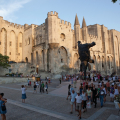The Palais des Papes, a major monument in the PACA region, sits at the gateway to Provence, where the Rhône meets the Durance.
At the gates of Provence, where the Rhone meets the Durance, the Palais des Papes proudly stands with its fortress-like appearance. With more than 650 000 visitors per year, it is one of the ten most visited monuments in France. A true symbol of the influence of the Church on the Christian West in the 14th century, this monumental masterpiece of 15,000m2 is the largest fortress of the Middle Ages and the largest Gothic palace in Europe. Built in less than twenty years, starting in 1335, the palace - listed as a World Heritage Site by UNESCO in 1995 - was mainly designed by two popes, Benedict XII and Clement VI. Between 1309 and 1418, nine popes saw their destiny linked to that of Avignon, a city at the crossroads of the great roads of the Western world, and seven of them resided within the walls of the Palais des Papes. With its imposing architecture, the palace dominates the city with its high walls and expresses the omnipotence of papal power. It is a monument whose facade crushes us with all its height, built to express the power of the church over its kingdom. It has all the characteristics of a fortress and is endowed with the elements of military and defensive architecture, with its buttresses, its two turrets, its patrol paths, its roofs and its crenellations. But this formidable citadel, one of whose obvious reasons for existence is the protection of the popes, is also endowed with all the pomp of the pontifical.
But how to explain the presence in Avignon of a papal palace? To understand the reasons, we must plunge into a tormented period of pontifical history. At the beginning of the 14th century, it was not uncommon for popes to stay outside of Rome, depending on the political tensions and power struggles that were taking place in Europe. Rome was a turbulent city, plagued by constant intrigue and conflict. For their security, the popes moved between the major cities of the Papal States: this is known as papal nomadism. In 1305, the king of France, Philip the Fair, pressured the election of the archbishop of Bordeaux, who then became the second French pope under the name of Clement V. Under his pontificate, Avignon entered the great history of the church by becoming the official residence of part of the College of Cardinals. His successor, John XII, moved into the episcopal palace of Avignon, then installed on the site of the current Palais des Papes, which he transformed. It is only under Benedict XII, who succeeded him, that the construction of the new palace began, in 1335. This builder pope took over the organization of the existing building and built the Papal Tower, the papal apartments, the cloister, the consistory wing, several towers, the kitchens, the latrines, the chapel, etc. He richly decorated his palace with furniture and murals. His successor, Clement VI, continued to embellish the palace, adding new towers and making spectacular extensions, notably the Hall of the Great Audience and the Court of Honor. From 1378 onwards, two rival currents divided Christendom and Europe: the Great Schism saw two popes reigning simultaneously over Christendom, one based in Rome and the other in Avignon. Benedict XIII was the last pope to occupy the Palace of the Popes in Avignon, and the final return of the popes to Rome took place in 1420, under Martin V.
Occupied then by the Legates and Vices-legates from the XVth, transformed into barracks until 1906, the Palace of the Popes is the object of various restorations since then. Offering innumerable and incomparable riches, both architectural and pictorial, it makes visitors relive all the splendor of the papal court. Today, 25 rooms of the Palais des Papes are open to visitors. It takes a good hour to discover all the places to visit: the ceremonial rooms, the audience rooms, the chapels with their magnificent frescoes by the famous Matteo Giovanetti, the pope's private apartments and the three gardens restored to their medieval state. Thanks to the Histopad, an augmented reality touch pad, you can step back in time and rediscover the different rooms as they were when the popes resided in Avignon. The ceremonial rooms are restored to their original splendor and the murals to their original state. The papal gardens were restored between 2017 and 2020, and are now part of the tour circuit. Improved, enlarged and redesigned by the successive occupants of the palace, they now offer a 1,000m2 orchard, with access to the former kitchens, as well as the pope's private garden, of 600m2, to which he had private access from his apartments.
The monument also offers visitors regular cultural activities throughout the year. Visit the website to find out about the thematic exhibitions and tours that are organized during your stay. A range of educational workshops also allows the youngest visitors to try out techniques and skills that are on the verge of extinction, such as ceramic painting. During the summer season, a major art exhibition is held in the Grande Chapelle, while the famous Avignon Festival, created by Jean Vilar in 1947, takes place in July in the Cour d'Honneur of the Palace.
Did you know? This review was written by our professional authors.
Members' reviews on POPE'S PALACE
The ratings and reviews below reflect the subjective opinions of members and not the opinion of The Little Witty.
És una visita obligada si esteu per la zona, teniu el casc antic d'Avinyó que val molt la pena amb moltes botigues, i el seu emblemàtic pont.
Les vistes des del parc del costat tambè valen molt la pena.
















Très belle vue et surtout la promenade est magnifique